Method And System For A Gaming System User Interface
Lamb; William Douglas ; et al.
U.S. patent application number 17/107526 was filed with the patent office on 2021-03-18 for method and system for a gaming system user interface. The applicant listed for this patent is Video Gaming Technologies, Inc.. Invention is credited to Arvin Grande Abadilla, Jin Chen, Charles Stanley Curbbun, Julian Groeli, Matthew Kranz, William Douglas Lamb, William John Leach, Victor Brent McClearen, Daniel William Rice, Blake Chuanlun Wang.
| Application Number | 20210082237 17/107526 |
| Document ID | / |
| Family ID | 1000005240253 |
| Filed Date | 2021-03-18 |
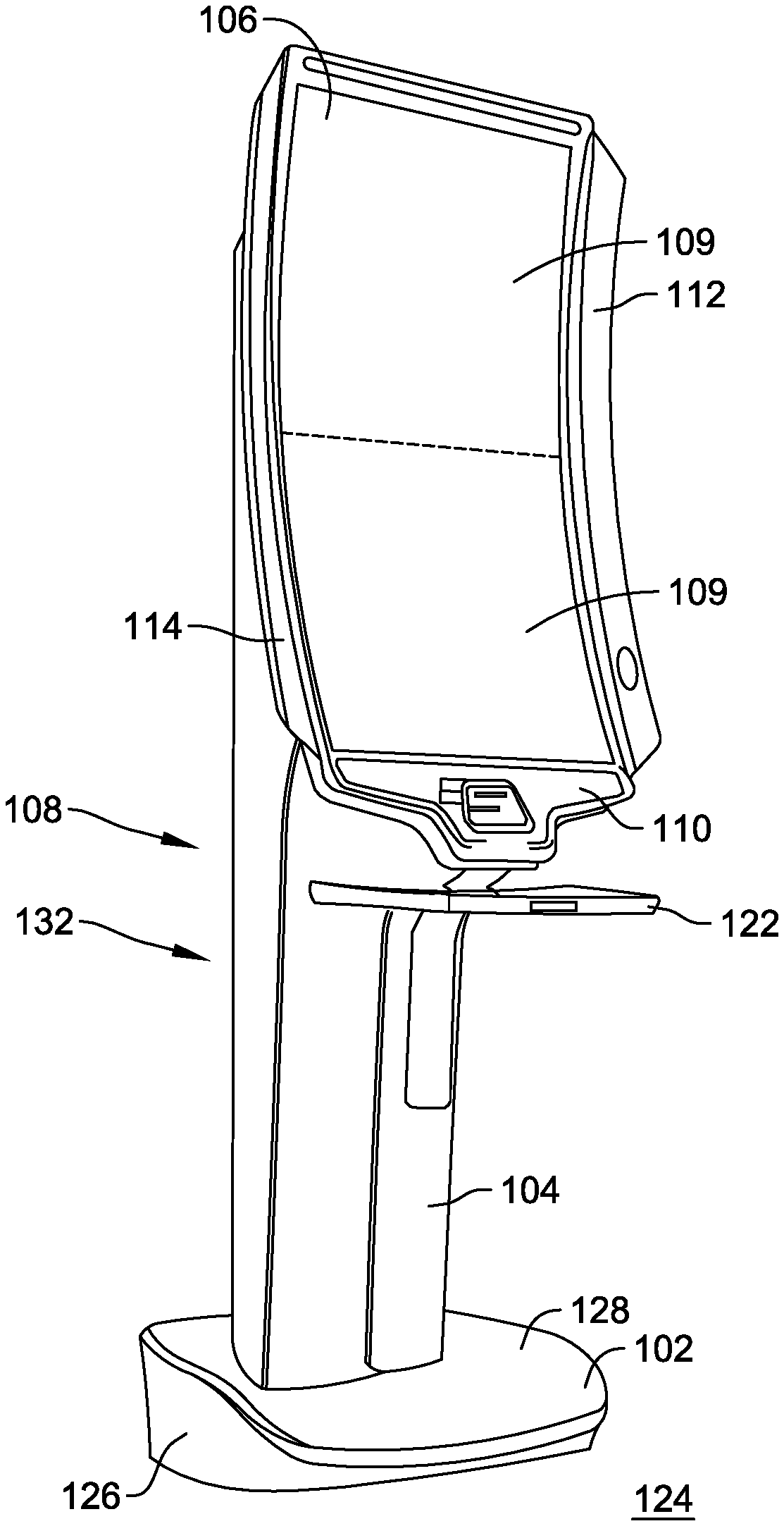
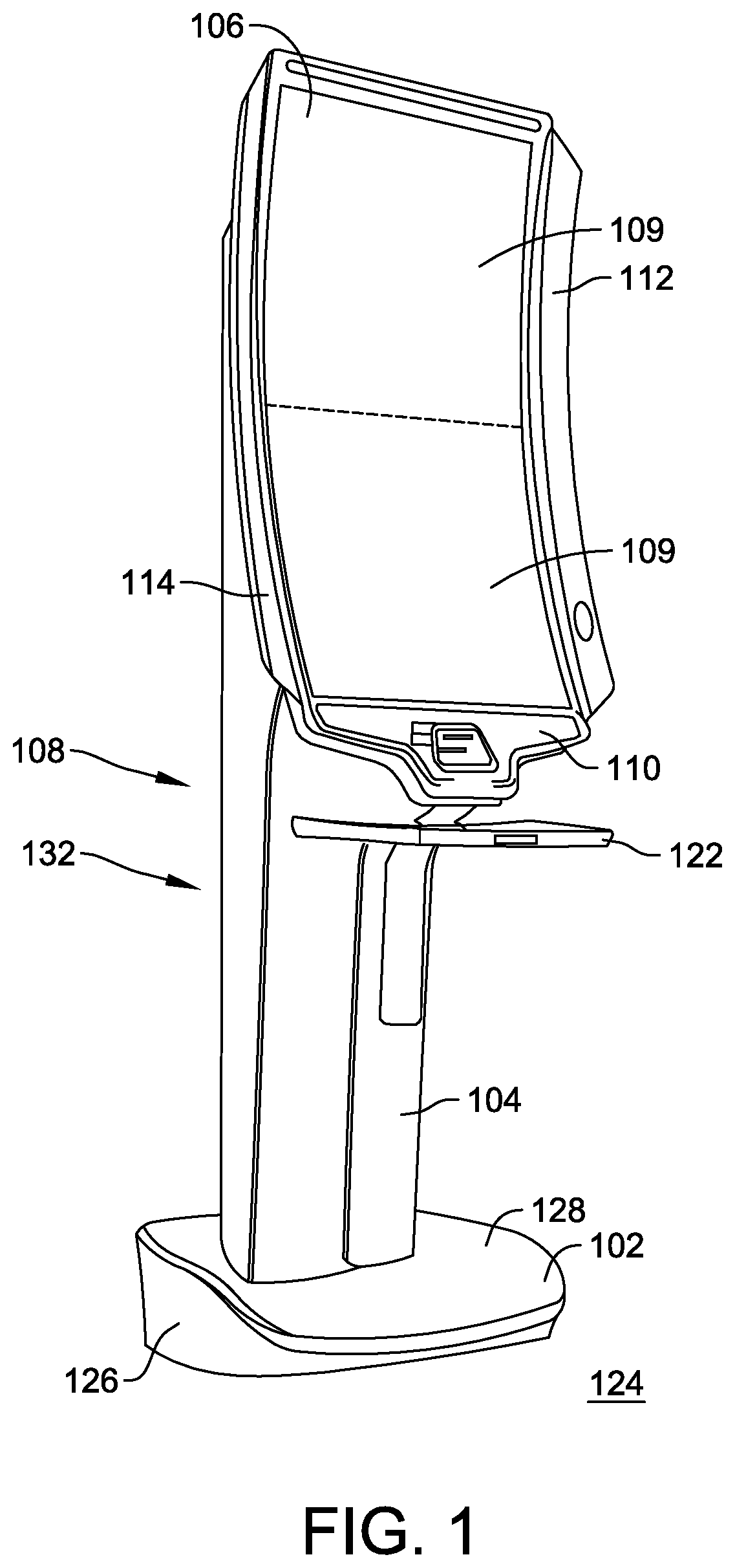
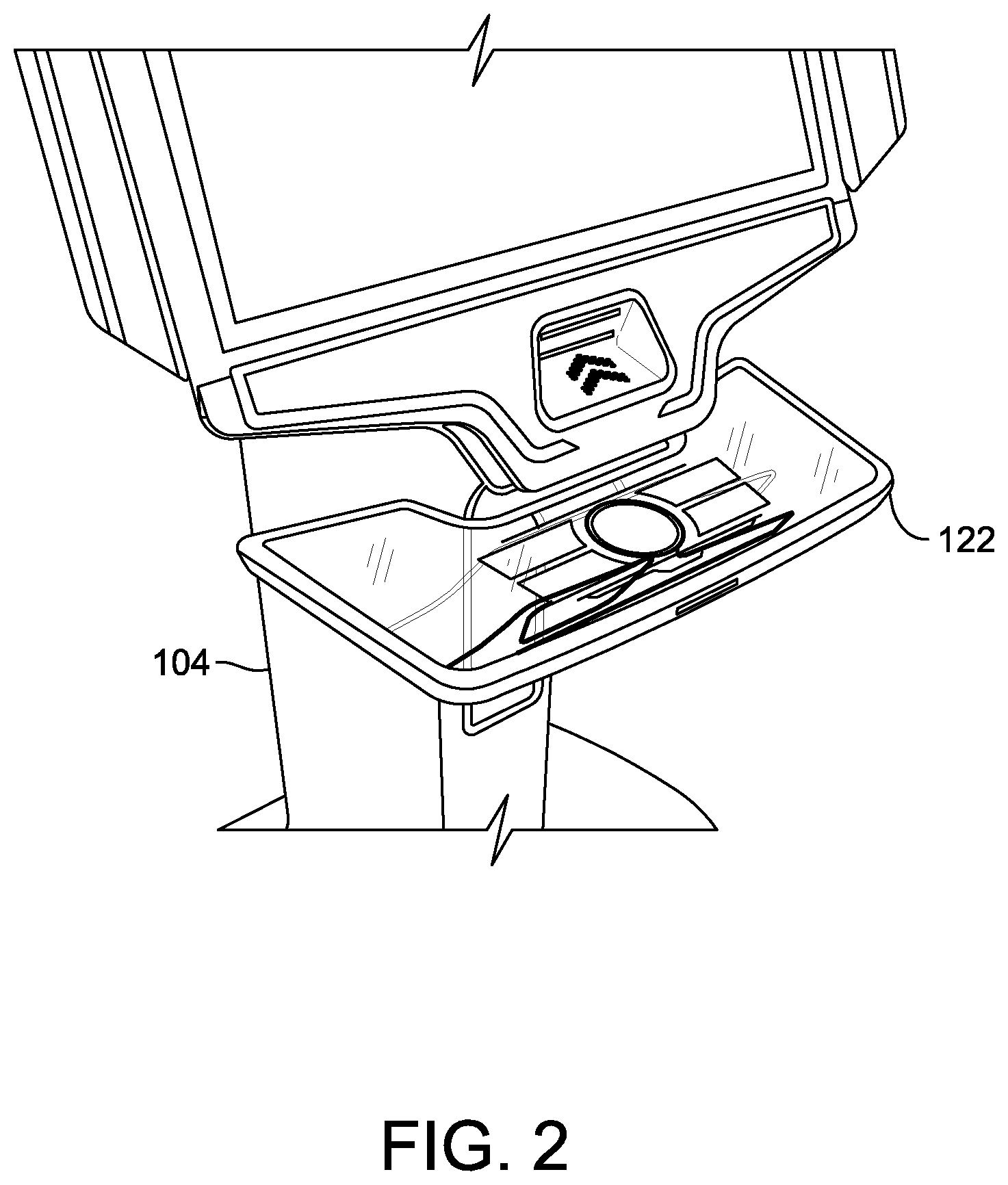
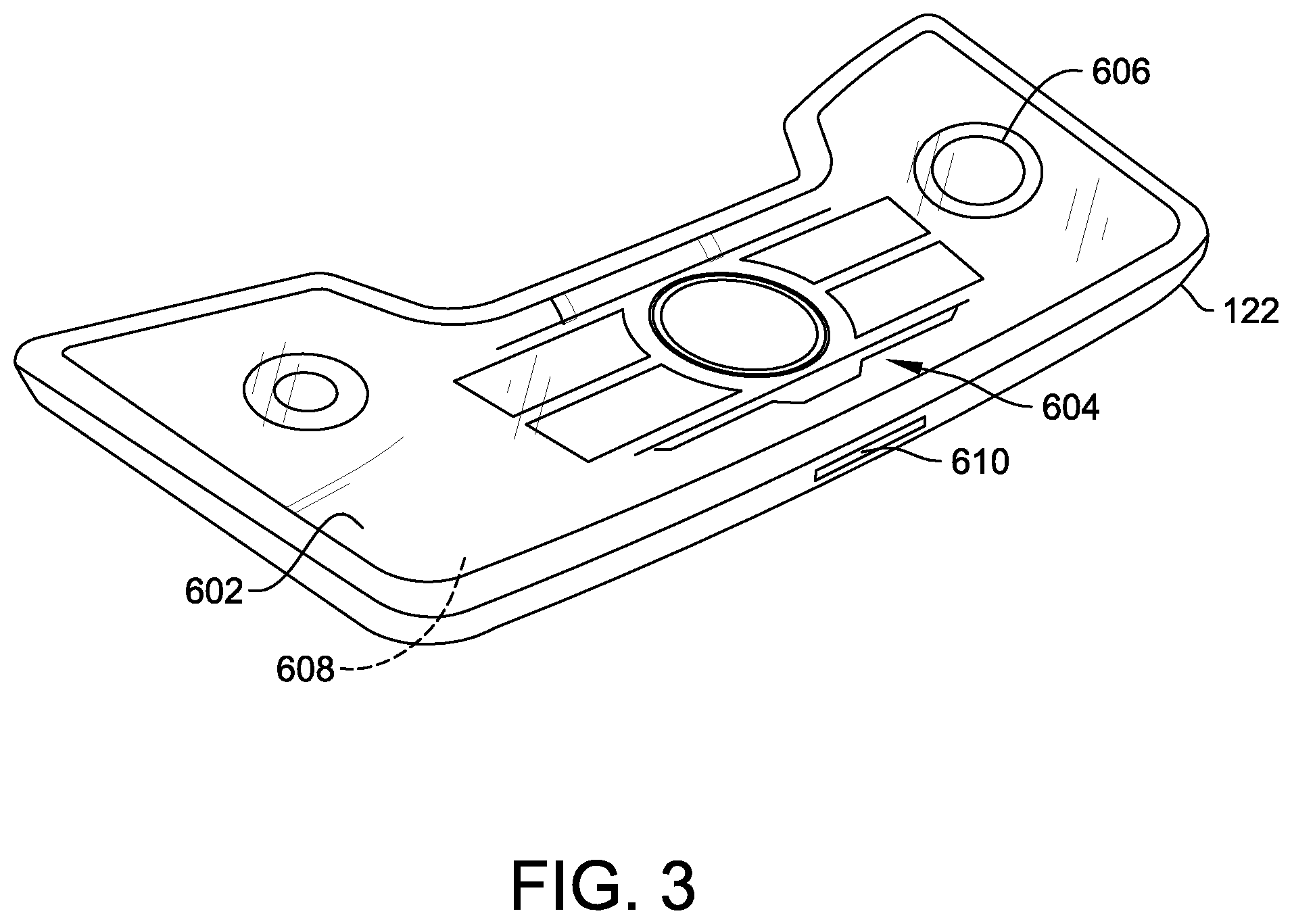
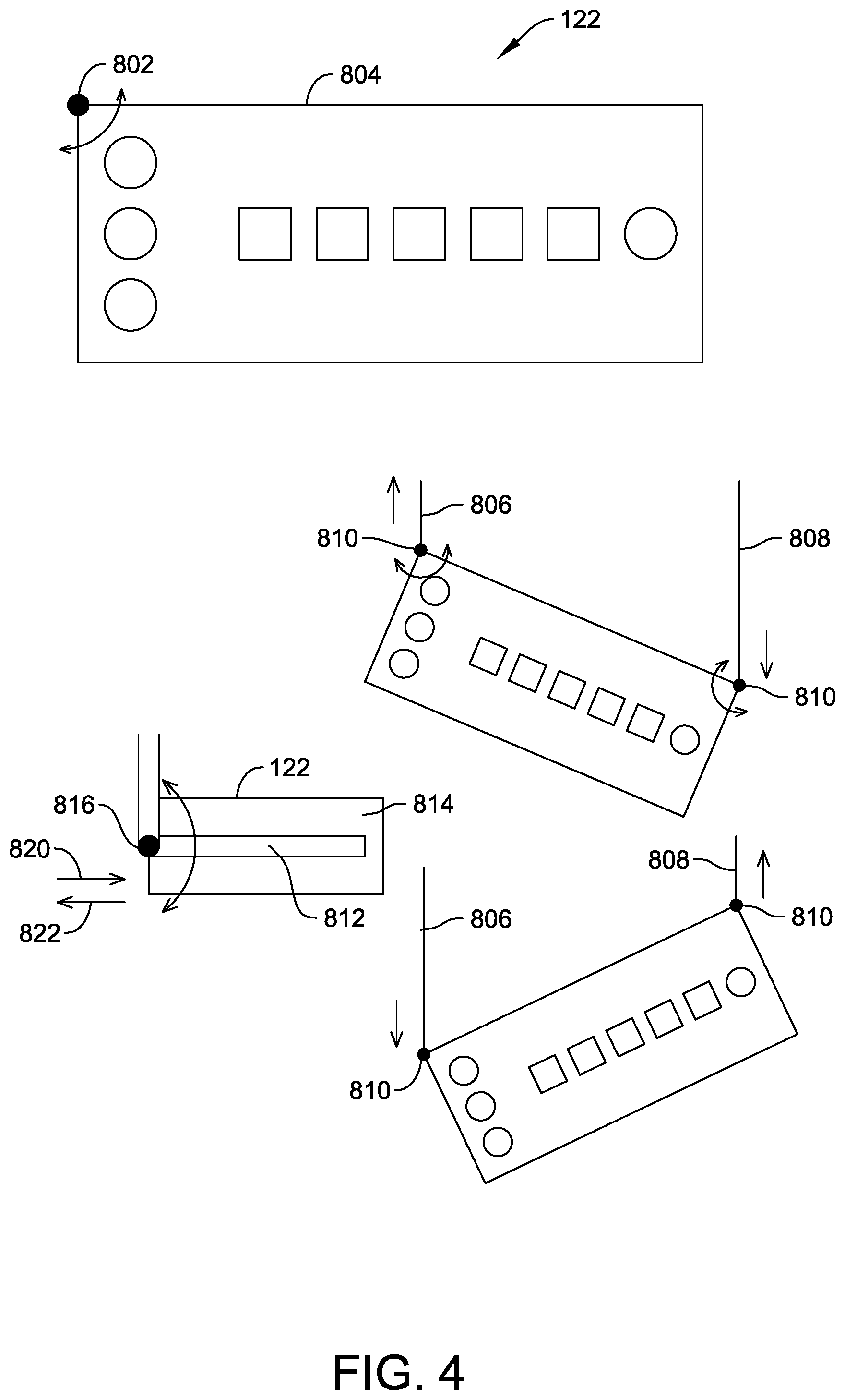
| United States Patent Application | 20210082237 |
| Kind Code | A1 |
| Lamb; William Douglas ; et al. | March 18, 2021 |
METHOD AND SYSTEM FOR A GAMING SYSTEM USER INTERFACE
Abstract
A gaming machine includes a base, a columnar pedestal extending vertically from the base, and a button deck adjustably coupled to the pedestal. The button deck includes an upper surface including a transparent touchscreen element, a lower surface opposite the upper surface, and a button deck body extending therebetween. At least one of the lower surface and the body include one or more transparent display elements, the one or more transparent display elements are configured to generate images of gaming machine control actuators viewable on the upper surface. The transparent touchscreen element is configured to receive touches and gestures indicating control inputs. The gaming machine also includes a player tracking card reader positioned within the button deck and accessible through a slot in a front edge of the button deck, the player tracking card reader communicatively coupled to a player tracking display area of the gaming machine.
| Inventors: | Lamb; William Douglas; (Eagleville, TN) ; Rice; Daniel William; (Thompson Station, TN) ; McClearen; Victor Brent; (Cookeville, TN) ; Curbbun; Charles Stanley; (Encinitas, CA) ; Abadilla; Arvin Grande; (Encinitas, CA) ; Kranz; Matthew; (Encinitas, CA) ; Groeli; Julian; (San Diego, CA) ; Wang; Blake Chuanlun; (San Diego, CA) ; Chen; Jin; (Carlsbad, CA) ; Leach; William John; (San Diego, CA) | ||||||||||
| Applicant: |
|
||||||||||
|---|---|---|---|---|---|---|---|---|---|---|---|
| Family ID: | 1000005240253 | ||||||||||
| Appl. No.: | 17/107526 | ||||||||||
| Filed: | November 30, 2020 |
Related U.S. Patent Documents
| Application Number | Filing Date | Patent Number | ||
|---|---|---|---|---|
| 14498638 | Sep 26, 2014 | 10854039 | ||
| 17107526 | ||||
| Current U.S. Class: | 1/1 |
| Current CPC Class: | G07F 17/3239 20130101; G07F 17/3211 20130101; G07F 17/323 20130101; G07F 17/3209 20130101; G07F 17/3213 20130101; G07F 17/3216 20130101; G07F 17/3227 20130101; G07F 17/34 20130101 |
| International Class: | G07F 17/32 20060101 G07F017/32 |
Claims
1. A gaming machine pedestal comprising: a button deck adjustably coupled to said pedestal, said button deck including one or more extendable arms, each arm coupled at one end to said pedestal and at a second end to said button deck, said button deck extendable away from and towards said pedestal; and a player tracking card reader positioned within said button deck and accessible through a slot in a front edge of said button deck.
2. The gaming machine pedestal of claim 1, wherein said one or more extendable arms include a first extendable arm and a second extendable arm, wherein said first extendable arm is configured to telescopingly extend independent of said second extendable arm.
3. The gaming machine pedestal of claim 1 further comprising one or more pivotable connectors each coupling said one or more extendable arms to said button deck, said button deck configured to pivot about said one or more pivotable connectors to adjust an orientation of said button deck relative to said pedestal.
4. The gaming machine pedestal of claim 3, wherein said button deck extends between the front edge and an opposed rear edge, wherein said one or more pivotable connectors are positioned at said rear edge.
5. The gaming machine pedestal of claim 4, wherein said button deck further comprises a first side and a second side each extending from said rear edge to said front edge, said button deck extending laterally between said first side and said second side, and wherein said one or more pivotable connectors comprises a first pivotable connector positioned adjacent said first side and a second pivotable connector positioned adjacent said second side.
6. The gaming machine pedestal of claim 5, wherein said one or more extendable arms comprises a first extendable arm and a second extendable arm, and wherein said first pivotable connector is coupled between said first extendable arm and said button deck and said second pivotable connector is coupled between said second extendable arm and said button deck.
7. The gaming machine pedestal of claim 5, wherein said button deck defines a first corner at an intersection of said rear edge and said first side, said button deck further defining a second corner at an intersection of said rear edge and second side, and wherein said first pivotable connector is positioned at said first corner and said second pivotable connector is positioned at said second corner.
8. The gaming machine pedestal of claim 1 further comprising one or more knobs each coupling said one or more extendable arms to said button deck, said button deck defining a track sized to receive said one or more knobs therein.
9. The gaming machine pedestal of claim 8, wherein said button deck comprises: an upper surface comprising a transparent touchscreen element; a lower surface opposite said upper surface; and a button deck body extending therebetween, wherein said track is defined within said lower surface.
10. The gaming machine pedestal of claim 8, wherein said button deck is extendable via said one or more extendable arms in a first direction away from and towards said pedestal, and wherein said button deck is slidable relative to said one or more knobs in a second direction laterally of said pedestal.
11. The gaming machine pedestal of claim 10, wherein the second direction is substantially perpendicular to the first direction.
12. The gaming machine pedestal of claim 10, wherein said button deck is rotatable about said one or more knobs to adjust an orientation of said button deck relative to said pedestal.
13. The gaming machine pedestal of claim 1, wherein said pedestal includes an actuator configured to facilitate extending said button deck away from and towards said pedestal.
14. A gaming machine comprising: a base; a columnar pedestal extending vertically from said base to an upper portion; a cabinet coupled to the upper portion of said pedestal and comprising a game display; a button deck adjustably coupled to said pedestal, said button deck including one or more extendable arms, each arm coupled at a first end to said pedestal and at a second end to said button deck, said button deck extendable away from and towards said pedestal; and a player tracking card reader positioned within said button deck and accessible through a slot in a front edge of said button deck.
15. The gaming machine of claim 14, wherein said one or more extendable arms include a first extendable arm and a second extendable arm, wherein said first extendable arm is configured to telescopingly extend independent of said second extendable arm.
16. The gaming machine of claim 14 further comprising one or more pivotable connectors each coupling said one or more extendable arms to said button deck, said button deck configured to pivot about said one or more pivotable connectors to adjust an orientation of said button deck relative to said pedestal.
17. The gaming machine of claim 16, wherein said button deck extends between the front edge and an opposed rear edge, wherein said one or more pivotable connectors are positioned at said rear edge.
18. The gaming machine of claim 17, wherein said button deck further comprises a first side and a second side each extending from said rear edge to said front edge, said button deck extending laterally between said first side and said second side, and wherein said one or more pivotable connectors comprises a first pivotable connector positioned adjacent said first side and a second pivotable connector positioned adjacent said second side.
19. The gaming machine of claim 18, wherein said one or more extendable arms comprises a first extendable arm and a second extendable arm, and wherein said first pivotable connector is coupled between said first extendable arm and said button deck and said second pivotable connector is coupled between said second extendable arm and said button deck.
20. A method of assembling a gaming machine including a pedestal, said method comprising: providing one or more extendable arms, each arm extending from a first end to a second opposed end; coupling the first ends of each arm to the pedestal; and coupling the second ends of each arm to a button deck to enable the button deck to be extended away from and towards the pedestal, wherein a player tracking card reader is positionable within the button deck and accessible through a slot in a front edge of the button deck.
Description
CROSS REFERENCE TO RELATED APPLICATIONS
[0001] This application is a divisional of, and claims priority to, U.S. application Ser. No. 14/498,638, filed Sep. 26, 2014, entitled "METHOD AND SYSTEM FOR A GAMING SYSTEM USER INTERFACE," the contents of which are hereby incorporated in their entirety.
BACKGROUND
[0002] This description relates to gaming machines, and, more particularly, to a method and system for enhancing player comfort and ergonomics in gaming machines.
[0003] Gaming machines have evolved to a substantially consistent form due to interchangeability and standardization considerations. For example, button layouts follow a standard linear arrangement in which players' must adjust their reach to accomplish different actions. Rather than assuming a more ergonomic configuration that is less fatiguing to players, buttons of gaming machines are arranged at consistent intervals in a straight line pattern. Additionally, gaming cabinets have a footprint at floor level that is either similar to and that exceeds the dimensions of the game itself. Often, gaming machines are placed on box stands to elevate them to a consistent height. However, the box stands also extend to a footprint that meets or exceeds the dimensions of the game. Players at such gaming machines are constantly at odds of being near enough to the machine to comfortably reach the game buttons, but far enough away from the gaming machine to have room to place their feet in front of them. Placement of the button panel or button deck is generally fixed on the front of the cabinet and is not adjustable to facilitate game play or player comfort.
[0004] Such discomforts and poor ergonomics affect player satisfaction with the gaming machine and the gaming experience and may affect revenues of the affected machines.
BRIEF DESCRIPTION
[0005] In an aspect, a gaming machine includes a base, a columnar pedestal extending vertically from the base, the pedestal having a cross-sectional area, a width, and a depth that are less than each of a corresponding cross-sectional area, width, and depth of the base, and a button deck adjustably coupled to the pedestal. The button deck includes an upper surface including a transparent touchscreen element, a lower surface opposite the upper surface, and a button deck body extending therebetween. At least one of the lower surface and the body including one or more transparent display elements, the one or more transparent display elements configured to generate one or more images of gaming machine control actuators viewable on the upper surface, the transparent touchscreen element configured to receive from a user at least one of touches and gestures indicating control inputs to the gaming machine, the at least one of touches and gestures corresponding to the generated images. The gaming machine also includes a player tracking card reader positioned within the button deck and accessible through a slot in a front edge of the button deck, the player tracking card reader communicatively coupled to a player tracking display area of the gaming machine.
[0006] In another aspect, a gaming machine includes a pedestal configured to support one of a plurality of interchangeable game cabinets through a pedestal mating flange configured to engage a complementary game cabinet flange, one or more mating plugs configured to engage a complementary one or more mating plugs positioned proximate the mating flanges, the mating plugs configured to join respective signal and power conduits between the pedestal and the game cabinet. The gaming machine also includes a button deck adjustably coupled to the pedestal. The button deck includes an upper surface including a transparent touchscreen element, a lower surface opposite the upper surface, and a button deck body extending therebetween. At least one of the lower surface and the body including one or more transparent display elements, the one or more transparent display elements configured to generate one or more images of gaming machine control actuators viewable on the upper surface, the transparent touchscreen element configured to receive from a user at least one of touches and gestures indicating control inputs to the gaming machine, the at least one of touches and gestures corresponding to the generated images.
[0007] In a further aspect, a gaming machine pedestal includes a button deck adjustably coupled to the pedestal, the button deck including one or more extendable arms, each arm coupled at one end to the pedestal and at a second end to the button deck, the button deck extendable away from and towards the pedestal, and a player tracking card reader positioned within the button deck and accessible through a slot in a front edge of the button deck.
BRIEF DESCRIPTION OF THE DRAWINGS
[0008] FIGS. 1-4 show example embodiments of the method and apparatus described herein.
[0009] FIG. 1 is a perspective view of a gaming machine in accordance with an example embodiment of the present disclosure.
[0010] FIG. 2 is a perspective view of a lower portion of the game cabinet in accordance with an example embodiment of the present disclosure.
[0011] FIG. 3 is an enlarged perspective view of the button deck shown in FIG. 1.
[0012] FIG. 4 is an illustration of embodiments of connections of the button deck to the column.
[0013] Although specific features of various embodiments may be shown in some drawings and not in others, this is for convenience only. Any feature of any drawing may be referenced and/or claimed in combination with any feature of any other drawing.
[0014] Unless otherwise indicated, the drawings provided herein are meant to illustrate features of embodiments of the disclosure. These features are believed to be applicable in a wide variety of systems comprising one or more embodiments of the disclosure. As such, the drawings are not meant to include all conventional features known by those of ordinary skill in the art to be required for the practice of the embodiments disclosed herein.
DETAILED DESCRIPTION
[0015] The following detailed description illustrates embodiments of the disclosure by way of example and not by way of limitation. It is contemplated that the disclosure has general application to gaming machine embodiments providing player comfort and ergonomic considerations in industrial, commercial, and residential applications.
[0016] The following description refers to the accompanying drawings, in which, in the absence of a contrary representation, the same numbers in different drawings represent similar elements.
[0017] FIG. 1 is a perspective view of a gaming machine 100 in accordance with an example embodiment of the present disclosure. In the example embodiment, gaming machine 100 includes a base 102 and a column 104 supported by base 102. A game cabinet 106 is coupled to an upper portion 108 of column 104. Game cabinet 106 includes one or more video display panels 109, a plurality of auxiliary devices, such as, but, not limited to a first user interface 110, a first side panel 112, and a second side panel 114. Gaming machine 100 also includes a button deck 122 adjustably coupled to column 104, game cabinet 106, and/or first user interface 110.
[0018] In the example embodiment, base 102 is configured to rest on or be coupled to a lower horizontal surface such as, but, not limited to, a floor 124. Base 102 includes one or more vertically upwardly extending sidewalls 126, which may include straight panels, and/or curved and contoured panels, such as, but, not limited to a circular, oval, oblong, and/or irregularly curved cross-section. Base 102 includes an upper surface 128 configured to fair base 102 by producing a closed smooth outline, support column 104, and/or provide a resting place for a user's feet.
[0019] Column 104 is a rigid, relatively slender, upright support, composed of relatively few components that extends vertically between base 102 and game cabinet 106. In various embodiments, column 104 includes a cylindrical or polygonal shaft 132. Column 104 houses various components and conduits that are configured to support the operation of gaming machine 100 and its integration into a larger operation and control network (not shown), in which gaming machine 100 is in communication.
[0020] In various embodiments, button deck 122 is mounted to column 104 and is controlled through a gaming machine 100 controller (not shown in FIGS. 1 and 2). In one embodiment, button deck 122 is configured to translate with respect to column 104 in a single direction, for example, towards and away from column 104. In some embodiments, the translation is controlled manually by the user, automatically by a motor, or combinations thereof. For example, when gaming machine 100 detects a user entering a proximity of gaming machine 100, button deck 122 may be commanded to translate in either direction to indicate to the user that button deck 122 is movable. The user may then adjust button deck 122 manually by hand, manually through operation of a switch controlling the button deck motor, or allow button deck 122 to be controlled automatically by gaming machine 100. The user may also turn off the automatic translation feature using an override switch (not shown). Button deck 122 may be configured to translate in a plurality of directions and/or rotate around a plurality of axes to suit the user's comfort and ergonomic control.
[0021] FIG. 2 is a perspective view of a lower portion of game cabinet 106 in accordance with an example embodiment of the present disclosure. FIG. 3 is an enlarged perspective view of button deck 122. In the example embodiment, button deck 122 includes an upper input surface 602 that may be embodied in a touchscreen surface or may be embodied in a combination of touchscreen elements 604 and mechanical input devices 606. For example, upper input surface 602 may include touchscreen elements for inputting various wager amounts, a "service" call button, a "cash-out" button, and other input requirements and also include a mechanical "spin" button 606. Touchscreen elements 604 may be isolated to certain areas of surface 602 and may be fixed in their function. However, in some embodiments, touchscreen elements 604 may be relocatable on surface 602 and may be reconfigurable to perform different functions during different portions of a game or for different games, such as when game cabinet 106 is interchanged. In one embodiment, button deck 122 is at least partially transparent or translucent, which permits a user to see through button deck 122, permits light from sources below button deck 122 to be seen by the user, and gives an appearance of mechanical "spin" button 606 and touchscreen elements 604 floating in front of the user.
[0022] Upper input surface 602 also may include an element 608 configured to control an opacity of button deck 122. Element 608 may comprise a liquid crystal display (LCD) element or other element configured to be electrically controlled to alter its transmissive properties. Element 608 may be configured to control opacity of button deck 122 as a whole or may be configured to control smaller regions of button deck 122 to present graphical objects to the user.
[0023] Button deck 122 also includes a card reader 610 for player tracking and communication. Card reader 610 is a part of a player tracking system that receives a player tracking card inserted and removed by the user. Card reader 610 transfers information stored on a player card to gaming machine 100. Gaming machine 100 is configured to provide player information on a player information portion (not shown in FIG. 6) of video display panel 109. In one embodiment, the player information portion is a reserved area that can be observed during game play. In other embodiments, the player information portion is overlaid onto a game screen during play or between games. When the player information portion is reserved, player information may only be displayed during predetermined times or when activated by the user. In other embodiments, the player information is dimmed or grayed out so as not to detract from the appearance of the game during game play.
[0024] FIG. 4 is an illustration of embodiments of connections of button deck 122 to column 104. In a first alternative embodiment, button deck 122 is pivotally coupled to column 104 through a pivot point 802 located along a rear edge 804 of button deck 122. In the example embodiment, pivot point 802 is positioned in a corner of button deck 122, however pivot point 802 can be located at any position along rear edge 804. A second alternative embodiment includes a first support arm 806 and a second support arm 808. In the example embodiment, support arms 806 and 808 are telescoping in that one of first support arm 806 and second support arm 808 may be extended at different rates and/or distances to permit button deck 122 to be angled with respect to column 104. Such an orientation may be beneficial to, for example, a user that is not positioned directly in front of gaming machine 100. To support such movement, a connection point 810 between first support arm 806 and second support arm 808 and button deck 122 is pivotable about connection point 810. A third alternative embodiment is illustrated where a track 812 along an underside 814 of button deck 122 is configured to receive a pivotable knob 816 coupled to an arm 818 extending from column 104. During operation, button deck 122 can be translated laterally along track 812 in a first direction 820 or a second direction 824 and/or rotated about knob 816 at any point along track 812.
[0025] This written description uses examples to describe the disclosure, including the best mode, and also to enable any person skilled in the art to practice the disclosure, including making and using any devices or systems and performing any incorporated methods. The patentable scope of the disclosure is defined by the claims, and may include other examples that occur to those skilled in the art. Such other examples are intended to be within the scope of the claims if they have structural elements that do not differ from the literal language of the claims, or if they include equivalent structural elements with insubstantial differences from the literal languages of the claims.
* * * * *
D00000

D00001

D00002

D00003

D00004

XML
uspto.report is an independent third-party trademark research tool that is not affiliated, endorsed, or sponsored by the United States Patent and Trademark Office (USPTO) or any other governmental organization. The information provided by uspto.report is based on publicly available data at the time of writing and is intended for informational purposes only.
While we strive to provide accurate and up-to-date information, we do not guarantee the accuracy, completeness, reliability, or suitability of the information displayed on this site. The use of this site is at your own risk. Any reliance you place on such information is therefore strictly at your own risk.
All official trademark data, including owner information, should be verified by visiting the official USPTO website at www.uspto.gov. This site is not intended to replace professional legal advice and should not be used as a substitute for consulting with a legal professional who is knowledgeable about trademark law.